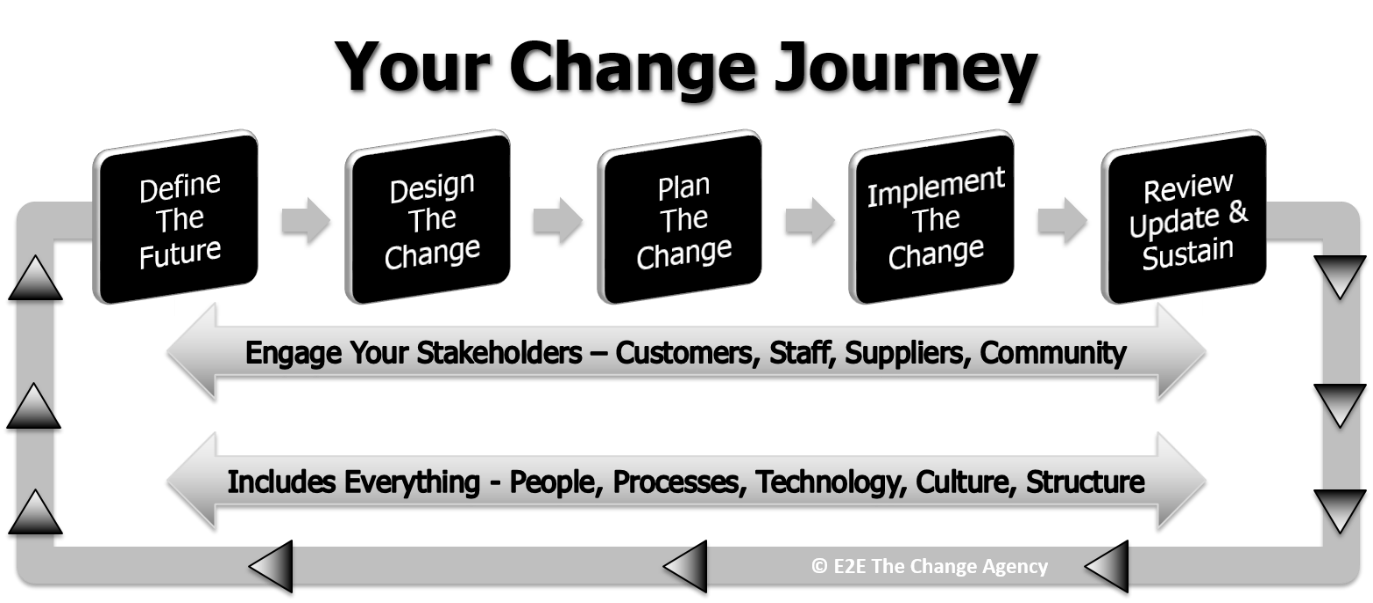When your organisation decides to make a change, especially a major one, the decision kicks off lots of activity.
It will also kick off lots of emotions and reactions amongst your staff, managers, customers, suppliers and anyone else involved in your organisation. This is the start of the change journey for your organisation and your people.
Your organisation’s change journey focuses on how you will reach the desired future. A well managed journey will move through the following phases:

The People Change Journey
The people change journey focuses on where the change will take them. How they will benefit or lose out because of the change.
The change journey for each person will be unique.
Some will move through the process faster than others.
A person’s change journey will also be unique for each change they experience. It is shaped by the personal impact of the change. How engaged and supported they feel through the change process.
For example: One of your team may be supportive and positive of a change in office locations because it makes life easier for them e.g. it will reduce travel time.
However, that same person may resist a change in computer systems because it means extra work for them.
One way to help bring your team along the change journey is to include them in various aspects of the change.
Returning to our example: If the team member is included in decisions about the new offices, e.g. layout and facilities, this will increase the potential for a positive change journey for them. Conversely, if they were excluded from providing input into the computer system’s selection or implementation plan, their resistance is highly likely to increase.
Connecting the Change Journey
By bringing your organisation’s journey and your people’s journey together, you will increase the potential that your desired future will be achieved.
When mapping your organisation’s change journey, include what your people will need to help them feel engaged and supported as they progress on their journey.
Bringing in a qualified Change Manager will help you manage the change process. A Change Manager will work with you to lead, guide and support your people so their journey aligns with your organisation’s. And that will create your desired future as positively as possible.
.

Engaging with your people
At each stage of the organisation’s change journey, it is important to engage with your people.
Ask them:
- What does the future look like?
- What needs to change?
- How could the change be made?
- How can an even better outcome, for the organisation and the people, be achieved?
Giving your people a role in guiding the journey increases their engagement with the change. It increases their understanding of why the change is needed and how it will occur.
Your people can be a great source of ideas of how the change can be best designed and delivered. The input from those who resist the change helps highlight potential issues before the organisation’s path is set in stone.
In addition, including clear activities in your organisation’s change journey that support your people’s change journey will increase the likelihood of successfully achieving your desired future.
Integrating your people and your organisation’s change journeys can be a very nuanced process. AccomplishBiz can guide you through the process to deliver your desired future.
Does your organisation need to implement a change?
We can provide practical help to define your future, design, and manage the changes required to achieve your future.



